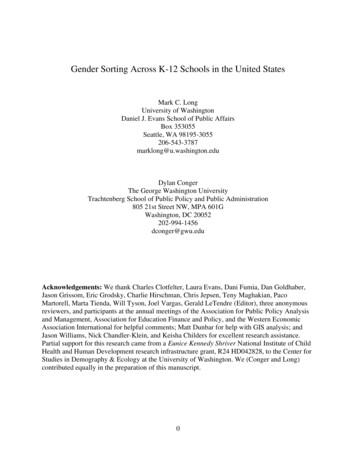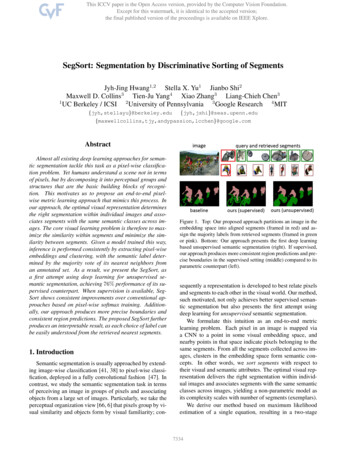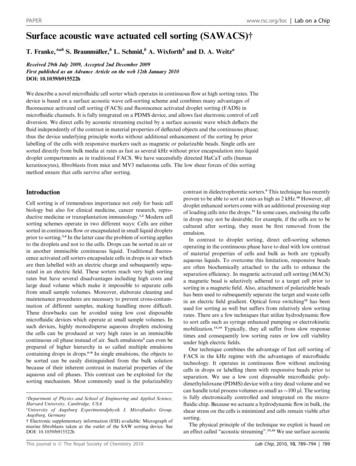
Transcription
Gender Sorting Across K-12 Schools in the United StatesMark C. LongUniversity of WashingtonDaniel J. Evans School of Public AffairsBox 353055Seattle, WA an CongerThe George Washington UniversityTrachtenberg School of Public Policy and Public Administration805 21st Street NW, MPA 601GWashington, DC 20052202-994-1456dconger@gwu.eduAcknowledgements: We thank Charles Clotfelter, Laura Evans, Dani Fumia, Dan Goldhaber,Jason Grissom, Eric Grodsky, Charlie Hirschman, Chris Jepsen, Teny Maghakian, PacoMartorell, Marta Tienda, Will Tyson, Joel Vargas, Gerald LeTendre (Editor), three anonymousreviewers, and participants at the annual meetings of the Association for Public Policy Analysisand Management, Association for Education Finance and Policy, and the Western EconomicAssociation International for helpful comments; Matt Dunbar for help with GIS analysis; andJason Williams, Nick Chandler-Klein, and Keisha Childers for excellent research assistance.Partial support for this research came from a Eunice Kennedy Shriver National Institute of ChildHealth and Human Development research infrastructure grant, R24 HD042828, to the Center forStudies in Demography & Ecology at the University of Washington. We (Conger and Long)contributed equally in the preparation of this manuscript.0
Gender Sorting Across K-12 Schools in the United StatesAbstract: This paper documents evidence of non-random gender sorting across K-12 schools inthe U.S. The sorting exists among coed schools and at all grade-levels, and it is highest in thesecondary school grades. We observe some gender sorting across school sectors and types: forinstance, males are slightly under-represented in private schools and charter schools, andsubstantially over-represented in irregular public schools, a large share of which educate studentswith special needs and juvenile justice involvement. Gender sorting within sectors and types isalso quite prevalent and appears to be highest within the private schools (where single-sexschools are more common) and irregular public schools. We find that gender sorting is higher incounties that have higher shares of enrollment in private and non-regular public schools. Thissorting occurs even though parents have similar stated preferences for school attributes for theirsons and daughters.Keywords: Gender disparities, school choice1
Gender Sorting Across K-12 Schools in the United States1. IntroductionSocial science researchers have documented the magnitudes, causes, and consequences of racialand socioeconomic sorting of students across U.S. schools for decades. In contrast, very littleattention has been paid to the sorting of males and females across schools. This gap in theliterature thus far exists for understandable reasons. Unlike racial and socioeconomic sortingwhich are fostered by discrimination and limited economic mobility, it's not clear that anyinjustices exist when males and females opt for different schooling environments. Modern-daygender disparities in educational outcomes among U.S. students also tend to be smaller thanracial and socioeconomic disparities. In addition, single-sex schooling is somewhat uncommonin the U.S., particularly in public schools, providing researchers with few reasons to investigategender sorting in the public school system.Yet recent educational trends suggest that perhaps more attention should be paid to thegender composition of the nation's schools. To begin, U.S. girls are now outperforming boys inmany aspects of educational performance. Girls have higher reading achievement in all grades(but lower math achievement after kindergarten) (Fryer and Levitt 2010; Robinson andLubienksi 2011), are more likely to graduate high school (Heckman and LaFontaine, 2010), takemore rigorous high school courses (Conger and Long 2010; Peter and Horn 2005; Riegle-Crumb2010), and are more likely to attend and complete college (Conger and Long 2010; Dynarski2007). There is also some evidence that several of these gender gaps are widening (Hussar andBailey 2011). Research that attempts to explain these female academic advantages often point togirls' higher performance in non-cognitive areas, such as organization, self-discipline,attentiveness, dependability, and seeking help from others, which can translate into higher2
parental, peer and teacher expectations (DiPrete and Jennings 2012; Jacob 2002; Reynolds andBurge 2008; Riegle-Crumb 2010).Even if these gender gaps in achievement are not of great concern to educators andacademics, given the advantage that females have in many academic areas, public and privateschools seeking to improve their school-wide achievement measures might benefit from simplyrecruiting and/or admitting more female students. Schools that are governed by state and federalaccountability policies might seek to improve their accountability scores by attracting morefemale students or, for those that are able to choose students, deliberately considering gender inthe selection process.In addition, recent amendments to Title IX provide public schools and school districtsgreater flexibility in offering single-sex classrooms and schools, and recent evidence suggeststhat such gendered schooling contexts are on the rise (Schemo 2006; USDOE 2008). Severalrecent studies on peer effects also demonstrate that the gender composition of students' schoolsand classrooms can influence their achievement and attainment (Hoxby 2000; Lavy andSchlosser 2011; Whitmore 2005). Proponents of single sex schooling have long held that boysand girls learn differently and that coeducational schooling environments can inhibit learning andreinforce gender stereotypes by, for instance, steering girls away from science and technologyand steering boys away from arts, music, and dance (National Association for Single Sex PublicEducation, 2012). Observations of classrooms also reveal that male students are often morevocal and distracted than female students, which can occupy teacher time and detract from thelearning environment (Younger, Warrington, and Williams 1999). More disruptive boys couldalso impact the patience and instructional ability of the teacher as well as the behavior of theother students (both boys and girls) in the schooling environment. At least one observational3
study suggest that the group most harmed by the presence of boys may be boys themselves: inintegrated classrooms, teachers have been observed to respond more positively to the lessdisruptive girls and interact with them in ways that support their learning (Younger et al. 1999).The few studies that attempt to quantify the effect of male peers in U.S. classrooms and schoolson student achievement primarily find negative effects (Hoxby 2000; Whitmore 2005). Thus, ifboys and girls attend different schools, even if the quality of the teachers and demographiccomposition of the students are equal, the greater exposure of boys to other boys could lowertheir achievement.Further, even if girls do not make for better peers, variations in the characteristics of theschools that males and females attend could matter to their educational outcomes. If, forinstance, females over-sort into schools with higher-quality teachers and stronger academicprograms, such enrollment patterns could widen gender disparities in academic outcomes.Consistent with this hypothesis, we find that differences in the public high schools attended byboys and girls in Florida explain 11% of the gender gap in their likelihood of college enrollment(Authors, 2012).These findings call for a thorough empirical examination of the degree to which boys andgirls sort across schools in the U.S. and the variation in the magnitude of the sorting acrossgrade-levels, school types, and communities. This paper provides, to our knowledge, the firstsuch inquiry. Using multiple sources of data on schools, students, and guardians, we examine theseverity and patterns of gender sorting across K-12 schools in the U.S. Specifically, we answerthe following questions: (1) What is the magnitude of gender sorting across schools and howdoes it vary by grade level?; (2) How does gender sorting vary across school sectors (private,public) and types (e.g., magnet, charter)?; (3) How does gender sorting across schools vary4
across counties in the U.S. and how much of the variation across counties is attributed to theextent of local school choice options?; and (4) Do guardians report different preferences forschool attributes based on the gender of their children? Our answers to these four questionsprovide insight into the magnitude of gender sorting and shed some light on its sources.We document a non-trivial amount of gender sorting across schools that has as yet goneunnoticed. This gender sorting is substantially (and statistically significantly) greater than whatwould be observed if boys and girls were randomly allocated to their schools. In addition, wedocument wide variation in gender sorting across counties in the U.S. that can be linked to theavailability of school enrollment choices. Finally, an investigation into the stated preferences ofparents provides limited evidence to explain why the sorting exists.The paper is organized as follows. Section 2 describes the relevant literatures. Section 3describes the data sources and methods. Section 4 provides the results and Section 5 provides adiscussion and conclusion.2. Literature ReviewThough we know of no study that examines the distribution of males and females across allschools in the U.S., there are a handful of studies that provide some evidence of gender sortingacross sectors and types. Several studies find that girls disproportionately enroll in charterschools and that the disparities are larger in secondary school than in earlier grades(Abdulkadirogu et al. 2009; Booker et al. 2009; Corcoran and Jennings 2011; Hoxby and Muraka2007). Further, given males disproportionate enrollment in special education (Hibel, Farkas, andMorgan 2010) and in the juvenile justice system (Tracy, Kempf-Leonard, and Abramoske-James2009), we expect higher gender sorting when public schools that serve these populations5
(referred to below as “irregular” public schools) are included with regular public schools. Giventhat students' preferences for school characteristics and knowledge of schooling options likelyincrease as they age, we also expect to see gender sorting increase with grade level as olderstudents assert their preferences and bargain with their parents.The degree of gender sorting within one sector or type will also likely influence thedegree to which it is observed in another type at the local level. Private, charter, and magnetschools may be more or less suited for children based on gender, which will affect the genderratio of students' in the remaining school types. For instance, an all-girls private school couldlead to a higher share of males in the local public school. Consequently, we expect that morelocal school options will increase the capacity for parents and students to make differentialenrollment decisions based on the student’s gender and lead to higher levels of gender sortingacross schools of all types.As for why gender sorting might exist, we have only limited information in the existingliterature from which to draw. Surveys of parents choosing schools indicate that they consider anumber of characteristics, such as student achievement, proximity to home, teacher quality,school safety, extra-curricular activities, athletics programs, and the composition of the studentbody (Rose 2001). In addition, we know that parent characteristics (such as education andrace/ethnicity) affect the kind of information that parents have access to and how they use theinformation to make their choices (Henig 1994; Petroni 1996; Piché and Taylor 2004;Robenstine 2001; Schneider, Teske, and Marschall 2000). Though most of the school choiceliterature has focused on across-family differences, there is some evidence that parents alsoevaluate schools differently depending upon the gender of their child (David 1997; Jackson andBisset 2005) and that boys and girls of secondary school age evaluate schools differently6
(Hastings, Kane, and Staiger 2006). In their study of the effects of the Charlotte-Mecklenburgschool choice program, Hastings et al. (2006) find, for instance, that white females are morelikely than white males to enroll in academically-focused schools. Based on survey data fromthe United Kingdom, David (1997) finds that parents of girls were more likely to statepreferences for single-sex schools, while parents of boys were more likely to consider thefacilities available in coed schools in making their choices. Likewise focusing on UK schools,Jackson and Bisset (2005) find that parents often assume that single-sex schools are better forgirls than they are for boys because boys are thought to dominate classroom interactions, andthus prefer same-sex schools for their daughters.Given this evidence of gendered preferences, gender sorting across schools could resultfrom parents choosing different schools for their daughters and sons (within-family sorting) orfrom across-family sorting if families with only sons are more inclined to send their boys toprivate schools while families with only daughters are more inclined to send their girls to thelocal public school. Sorting by gender could be driven by tastes for same-sex peers or by thecharacteristics of schools that are correlated with one gender (e.g., a science and tech school maydraw a disproportionate share of males).3. Data and Methods3a. Data SourcesWe rely on three data sources for our analyses. To examine the magnitude of gender sorting ineach K-12 grade within the public and private school systems, we use two data sourcesmaintained by the U.S. Department of Education. The first is the 2007-08 Common Core ofData Public Elementary/Secondary School Universe Survey (CCD), which contains enrollment7
counts by gender and grade for the census of public schools in the U.S. We restrict our analysisto schools in the 50 states plus the District of Columbia. Very few public schools are missingenrollment counts (ranging from 0.009% for schools offering 2nd grade to 0.035% for schoolsoffering 12th grade). We drop from our analysis schools that only have ungraded students(229,528 students) and include schools with graded students (47,207,507 students in K-12).The CCD distinguishes among schools according to whether they are regular, special education,vocational, or other/alternative (e.g., juvenile justice school). We group the latter threecategories together and refer to them as "irregular" public schools. Schools are also separatelyidentified according to whether they are charter1 or magnet2 schools. Irregular, magnet, andcharter designations are not mutually exclusive. That is, some schools are designated as both amagnet and a charter school, etc. Further, magnet and charter schools can be either regular orirregular. Thus, when we restrict the analysis to just magnet schools, as we do in the fourth row1Defined as a “A school that provides free elementary and/or secondary education to eligiblestudents under a specific charter granted by the state legislature or other appropriate authority.”(Chen, 2011, p. A-5).2Defined as “Regardless of the source of funding, a magnet school or program is a special schoolor program designed to attract students of different racial/ethnic backgrounds for the purpose ofreducing, preventing, or eliminating racial isolation and/or to provide an academic or socialfocus on a particular theme” (Chen, 2011, p. A-5). A number of states did not report the magnetstatus of their schools to CCD in 2007-08 (including AZ, HI, IA, MA, MT, NE, NH, NJ, OH,OK, OR, RI, SD, TX, VT, WA, WV, WY) despite the fact that many if not all of these statescontain magnet schools (“Magnet” is in the name of schools in AZ, MA, NE, NJ, OR, TX).8
in Table 2 for example, this set of schools will include regular and irregular schools, as well ascharters and non-charters.The second source of data is the 2007-08 Private School Universe Survey (PSS), whichcontains enrollment counts for most private schools in the country.3 Though the PSS providesthe total number of males and females in the school as well as the number of students in eachgrade, it does not provide the gender breakdown of students within each grade. To overcomethis limitation, we impute the gender composition of each grade by randomly allocating malesand females across the grades such that the school-level enrollment of males and females as wellas the grade-level enrollments match those recorded in the PSS.4 This procedure assumes nogender sorting across grades within a private school (except that which would occur by chance)and, consequently, yields conservative estimates of grade-level gender sorting within privateschools. Differences in the magnitudes of gender sorting across grades will only be driven bygender sorting across schools that offer certain grades (for instance, if K-2 schools are32007-08 is the most recent year available for the PSS. Broughman et al. (2009) report that theweighted survey response rate was 91.1%. We use the weights supplied by the U.S. Departmentof Education to make the PSS sample representative of all private schools. Using these weights,we find that 84% of private schools (enrolling 88% of private school students) are included assurvey respondents.4For example, suppose a school contains 40 males, 60 females, 55 kindergarteners, and 45 firstgraders. To estimate the number of males and females in each grade, we first create a fictionaldataset composed of 40 males and 60 females. We then randomly draw a fictional student fromthis dataset (without replacement) and randomly place him or her into either kindergarten or firstgrade (stopping with enrollment counts of 55 and 45 in these grades).9
disproportionately female, we may observe higher rates of gender sorting in these early gradesrelative to later grades).Both the CCD and the PSS provide the address of each school, which allows us tomeasure the number and type of schools located in each county as well as the amount of acrossschool gender sorting within each county in the U.S.Our third source of data, which we use to examine whether guardians' preferences forschools vary by the gender of their children, is the Parent and Family Involvement in Education(PFI) portion of the 2007 National Household Education Survey (NHES). The NHES is arandom-digit telephone survey of guardians conducted by the U.S. Department of Education.The 2007 survey includes responses from guardians in 10,633 households regarding 10,681children, and the PFI portion of the survey includes several questions about the information thatguardian’s collect and consider in choosing schools for their children.3b. MethodsWe measure the unevenness in the distribution of boys and girls across schools with the standarddeviation in schools’ male share of enrollment. As with all measures of unevenness, we note thateven if students were randomly assigned to their schools, the expected value of our measure islikely to be non-zero due to the natural features of randomness. That is, only a deliberate effortto achieve perfect gender balance would result in evenly distributed schools, while a randomallocation process is likely to deviate slightly from a perfectly even distribution. Moreover, arandom allocation process will yield a higher standard deviation in male share in sectors, grades,and geographic areas with smaller grade-level enrollments. Notably, the average size of private10
schools is much smaller than that of public schools, which will increase the standard deviation inmale share even if there is no systematic sorting.To quantify the amount of sorting that appears to be driven by non-random forces, wecompute the standard deviation in male share that would occur if students were randomlyassigned to their schools. Holding school sizes fixed at their actual values, we randomly allocatestudents to schools in 100 Monte Carlo simulations and report the mean of the standard deviationin male share that results from the simulations. 5 We then compute the "residual sorting" as thedifference between the true standard deviation and the mean standard deviation from the 100simulations. In addition to accounting for natural drivers of sorting, this residual adjusts for thefact that sorting will be mechanically higher in geographic areas and school types with smallerschools. We examine the amount of residual sorting for all schools, then separately for schoolsthat are private, regular public, irregular public, magnet, and charter.Finally, to examine the variation in across-school gender sorting by county, we computea measure of residual sorting for each of the 2,963 counties in the U.S. in 2007-08. That is, foreach county, we compute the actual level of gender sorting, the amount of gender sorting thatwould occur under a random allocation of students (based on the average of 10 Monte Carlosimulations for each county), and the difference between the two (the residual). We drop fromthe analysis counties that offer only one school for a given grade as there can be no gendersorting for that grade in the county. In addition to mapping and examining the variation ingender sorting across counties, we explore the relationship between the local school choice5Conger (2005) uses a similar procedure to identify within school racial sorting acrossclassrooms.11
options (the share of students in various school types) and the magnitude of residual sortingacross counties.4. Results4a. Across-school Gender Sorting by Grade LevelTable 1 provides the characteristics and amount of gender sorting across all schools in the nationin 2007-08 by grade-level. Approximately 4 million students were enrolled in each grade, withthe highest enrollments in the 9th grade (over 4.5 million students), which reflects the high graderetention rates of 9th graders. Middle and secondary schools are also smaller in number andlarger in size than elementary schools on average. Column (4) provides the male share of eachgrade, which peaks at 51.9% in the 9th grade due to higher grade retention rates among males(Heubert and Hauser, 1999) and falls to 50.0% in 12th grade given higher high school dropoutrates among males (Heckman and LaFontaine, 2010). Note that our analysis of across-schoolgender sorting within each grade-level will not be influenced by the variation in the male shareacross grades (which is driven by gender differences in enrollments, not school sorting).[INSERT Table 1]Beginning with Column (5), the table provides the first of several statistics that measurethe magnitude of gender sorting across schools by grade-level. Column (5) shows the standarddeviation in the male share across schools for each grade, which ranges from a low of 7.4percentage-points in the 8th grade to a high of 10 percentage-points in kindergarten. Asexplained above, the observed variation in the male share is driven by true systematic sorting ofmales of females as well as the non-systematic sorting that mechanically increases in gradeswhere the schools are smaller. To isolate the portion of the total sorting that is due to non12
random and non-mechanical influences, we provide the mean standard deviation obtained fromour 100 simulations of allocating students randomly to their schools in Column (6). Asexpected, the mean standard deviation in the randomly sorted simulations falls from the 5th to the6th grade, and again from the 8th to the 9th grade, due to the larger average enrollments of middleand secondary schools. Column (7) provides the percentage-point difference and Column (8)provides the percent difference between the actual and randomly-simulated deviations andreveals large differences, particularly in the high school grades where the actual sorting is morethan double what would be expected by chance. In the high school grades, the actual deviation is5 percentage-points higher (and over 100% higher) than the deviation from the randomdistribution.6 For each grade level K-12, the standard deviation of male share in the randomlysorted data was less than the standard deviation of male share in the actual distribution in all 100iterations. In other words, the p-value for a one-tailed test of the hypothesis that the randomallocation is greater than actual allocation is 0% for all grades, indicating that the non-randomgender sorting is statistically significant at all conventional levels of significance.The last column of Table 1 (Column 9) reveals that a small percentage of schools in theU.S. are single-sex schools, and that most of them serve the high school grades. In results notshown in Table 1 but available upon request, we examine the degree of residual sorting for each6In results not shown (but available on request) we find a very similar pattern when we computethe Index of Dissimilarity using the actual enrollment data and compare it to the Index ofDissimilarity using the randomly-sorted simulated data. The actual Index of Dissimilarity in thehigh school grades is 3-4 percentage-points higher than the Index of Dissimilarity computedfrom the random distribution, indicating that 3-4 percent of boys (or girls) would need to changehigh schools to produce the gender distribution that we would expect by chance.13
grade when single sex schools are removed from the analysis. We find that the amount ofresidual sorting in the high school grades is cut in half (for example, from 106% to 50% for the12th grade), which suggests that a bit more than half of the sorting observed in these grades is dueto single-sex schools. The remaining residual sorting demonstrates that a non-trivial amount ofgender sorting also exists across coed schools. Across all coed high schools, the standarddeviation of male share in the actual distribution of students is between 46% and 50% higherthan expected based on the random distribution.4b. Gender Sorting Within and Across School TypesFor our next analysis, we examine the degree to which males and females sort across sectors andschool types as well as the magnitude of the sorting that occurs within sector and type. Table 2provides the descriptive and sorting statistics for schools that are private, regular public, irregularpublic, magnet, and charter. To conserve space, we provide figures only for grades kindergarten,3, 6, 9, and 12 (analyses for other grades are similar to those reported in Table 2 and can beobtained upon request).Columns (1), (2), and (3) of Table 2 reveals the wide variation in the size and number ofstudents enrolled in schools from each type. Irregular public, charter, and private schools tendto be smaller than regular public and magnet schools, with magnet schools showing very highenrollments per school in the high school grades.[INSERT Table 2]Column (4) reveals substantial gender sorting across sectors and school types. At eachgrade-level, irregular public schools tend to enroll the highest percentage male, while privateschools tend to enroll the lowest percentage male. In kindergarten, for instance, 55.3% of all14
students in irregular public schools are male compared to only 38.8% of all students in privateschools. We remind the reader that we imputed the grade-level male share for private schoolsbased on the enrollments of each grade and the total male share in each school. The variation inthe male share across grades within the private school sector is, therefore, driven only by gendersorting across schools that offer certain grades.7 Our results suggest that private schools thatoffer lower grades (namely, K-3rd) have higher female enrollments than schools that offer highergrades (namely, 9th-12th). Between the two extremes of private and irregular public schools,Column (4) reveals a slight over-enrollment of males in regular public schools and an underenrollment of males in charter schools, particularly at the high school level.Columns (5), (6), (7), and (8) provide the analysis of gender sorting, with a comparisonof observed sorting to sorting under random allocation. For each grade-level, the amount ofresidual sorting (shown in Columns (7) and (8)) is much higher in the private schools than in thepublic schools. For instance, among private high schools (9th and 12th grades), the observedstandard deviation of male share is approximately 17 percentage-points higher (or double) whatwould be expected by chance. In contrast, gender sorting within the regular public schoolsystem is relatively low, especially in the lower grades, K through 6th.8 In secondary school,7If it is further true that within private schools there is gender sorting in the same direction (e.g.,that kindergarten in school j has a disproportionate female enrollment than first grade in schoolj.), then our method of random allocation would lead to an underestimate of the extent of gendersorting across schools serving a particular grade.8Though gender sorting is relatively low in the regular schools, the amount of gender sorting isstill statistically different than what would be expected under a random allocation of students toschools. In fact, the standard deviation of male share in the randomly sorted data was less than15
where students’ choices likely play a larger role, the difference between the observed sorting andsorting under random assignment is larger, but nowhere near the residual sorting observed in theprivate schools. Among the remaining three types of schools (irregular public, magnet, andcharter), there is some interesting variation by grade-level. In most grades, residual sorting ishigher in the irregular public schools than in the other two types of schools. Sorting tends to behigher in charter schools than in magnet schools in the early grades, but lower in the high
substantially over-represented in irregular public schools, a large share of which educate students with special needs and juvenile justice involvement. Gender sorting within sectors and types is also quite prevalent and appears to be highest within the private schools (where single-sex schools are more common) and irregular public schools.










